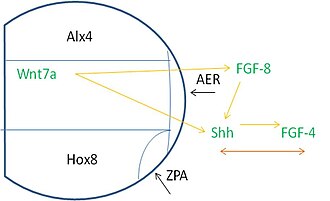Zone of polarizing activity
| Zone of polarizing activity | |
|---|---|

The apical ectodermal ridge is a thickened epithelium at the most distal end of the limb bud. The zone of polarizing activity is at the posterior part of the limb bud.
|
|
| Details | |
| Identifiers | |
| Latin | zona activitatis polarisantis |
| Code | TE E5.0.3.0.0.1.5 |
|
Anatomical terminology
[]
|
|
The Zone of Polarizing Activity (ZPA) is an area of mesenchyme that contains signals which instruct the developing limb bud to form along the anterior/posterior axis. Limb bud is undifferentiated mesenchyme enclosed by an ectoderm covering. Eventually, the limb bud develops into bones, tendons, muscles and joints. Limb bud development relies not only on the zone of polarizing activity, but also many different genes, signals, and a unique region of ectoderm called the apical ectodermal ridge (AER). Research by Saunders and Gasseling in 1948 identified the AER and its subsequent involvement in proximal distal outgrowth. Twenty years later, the same group did transplantation studies in chick limb bud and identified the ZPA. It wasn’t until 1993 that Todt and Fallon showed that the AER and ZPA are dependent on each other.
Patterning along the limb bud requires signals from many sources. Specifically, proteins called transcription factors (TF) help control the rate at which a gene is transcribed. The limb bud expresses a TF called ALX4 at the anterior part of the mesoderm, with the TF HOXB8 being expressed at the posterior portion. The Alx4 region, the medial region, and the Hox8 expressing area meet at a proximal area where the AER develops. The ZPA forms where the Hox8 region joins the AER.
These regions are dependent on signaling in order for the appropriate induction events to occur. The AER expresses FGF8 which induces Shh expression in the posterior mesoderm. Shh then stimulates FGF4 to be expressed in the posterior part of the AER. After these events, there is a co-dependence between FGF-4 and Shh for their subsequent expression and maintenance. Additionally, Wnt7a is expressed in the dorsal ectoderm, is needed to maintain the FGF and Shh signaling.
...
Wikipedia


